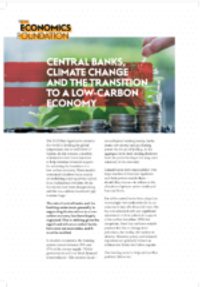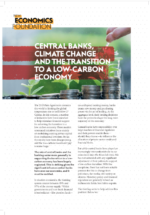Central banks, climate change and the transition to a low-carbon economy
Central banks should use their power to support low-carbon transition
07 September 2017
The 2015 Paris Agreement commits the world to limiting the global temperature rise to well below 2° Celsius. In this context, a number of initiatives have been launched to help stimulate financial support for achieving the transition to a low-carbon economy. These market-orientated initiatives focus mainly on mobilising existing private capital from institutional investors. So far, the results have been disappointing and the low-carbon investment ‘gap’ remains huge.
The role of central banks and the banking sector more generally in supporting the transition to a low carbon economy has been largely neglected. This is striking given the significant influence central banks have over our economies, and it must be rectified.
In modern economies, the banking system creates between 85% and 97% of the money supply.¹ Whilst governments and non-bank financial intermediaries – like pension funds – tax and spend existing money, banks create new money and purchasing power via the act of lending. At the aggregate level, their lending decisions have the power to shape the long-term trajectory of the economy.
Central banks have responsibility over large swathes of financial regulation and their powers enable them – should they choose – to influence the allocation of private-sector credit and financial flows.
But while central banks have played an increasingly interventionist role in our economies since the financial crisis, this has not coincided with any significant adjustment of their policies to support a low-carbon transition. With few exceptions, there has not been notable pressure for this to change from politicians, the media, civil society or citizens. Monetary policy and financial regulation are generally viewed as technocratic fields, best left to experts.
This briefing seeks to help address this problem. Below we:
1) Explain how central banks should play a more prominent role in supporting a low-carbon transition rather than maintain the status quo;
2) Identify some policy interventions that could help central banks address the growing challenges of climate change. In particular, we recommend a green macroprudential policy approach, green credit allocation interventions, and greening central bank balance sheets (also known as ‘Green QE’).
KEY POINTS:
- Central banks are publicly owned institutions. Their mandates should support the long-term public good, and environmental sustainability should be included in these objectives.
- Financial stability is a key part of existing central bank mandates, and climate change poses systemic risks to the financial system. There is therefore a clear case for a more interventionist approach.
- Current central bank policy risks reinforcing the current ‘carbon lock-in’ of energy systems centred upon fossil fuels, which endangers financial stability and undermines the Paris Agreement on climate change.
- The focus of financial regulators on encouraging greater disclosure of financial institutions’ exposure to climate change related shocks is welcome but insufficient given the urgency of action required.
- Policy must be redesigned to strengthen financial resilience, so that policy responses help the financial system absorb shocks, whilst adapting and transforming it so that it is less susceptible to future risks of climate change.
Notes
- McLeay, M., Radia, A. and Thomas, R., (2014). Money creation in the modern economy. Bank of England Quarterly Bulletin 2014 Q1. London: Bank of England.
Topics Banking & finance Climate change








